The Kodak View |
Read more at in70mm.com The 70mm Newsletter |
| Written and photographed by: Mark Trompeteler meets with Antonio Rasura, Director of Motion Picture Labs & Services at Kodak, to discuss modern day supply, processing and use of 65mm film. | Date: 15.07.2023 |
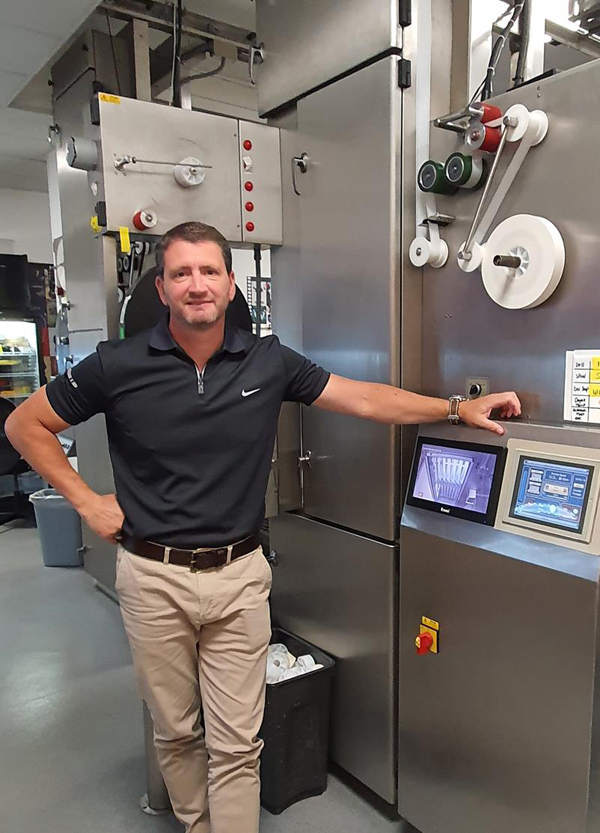 Antonio Rasura,
Director of Motion Picture Labs & Services at Kodak Antonio Rasura,
Director of Motion Picture Labs & Services at KodakIt is quite a few years ago, back in 2014/15/16, that Kodak, and other industry press releases, and items on this website, were heralding the return of film processing at Pinewood Studios on the outskirts of London. A little later I attended a British Society of Cinematographers screening of the emotionally devastating and harrowing film “Son of Saul”, shot on 35mm Film. At that BSC screening I had a brief conversation with Antonio Rasura, Director of Motion Picture Labs & Services at Kodak. We chatted very briefly about Kodak’s determination to re-establish a consciousness in the minds of Directors of Photography, and Directors, of the unique beautiful qualities of shooting on film in a digital age. Fast forward a few years and Antonio and I have both had an association with the International Moving Image Society (formerly BKSTS). The Society, has been through a difficult couple of years but is being reactivated by a small group of volunteers, one of whom is me. Close by the IMIS Pinewood office, Kodak have their laboratory in The Ken Adam Building. Kodak at Pinewood offers a comprehensive negative processing service for motion picture film. The lab has three Photomec processing lines that can handle over 100,000 ft a day, if needed. The lab and scanning services are operated by a small dedicated team of highly skilled film technicians. The facilities include a LaserGraphics ScanStation 65 with a 6.5k capability - as well as a Scanity HDR 4K scanner. The team offers a complete end to end process and scan service for 8mm, 16mm, 35mm & 65mm film – colour and B&W. For the purpose of archiving they can produce YCM digital separation masters and colour intermediates for preservation. The team work on major feature films, commercials, promos and archive projects. Antonio kindly allowed me to visit the lab on a day when they were doing a processing run of 65mm film. The photographs I took show the processing equipment path laced with 65mm leader, this is run through the processor in order to check the transportation and align the film path prior to the client’s film going through. Their 65mm processor is innovatively designed to be able to process both 35mm and 65mm film. To prepare the machine for 65mm processing takes about an hour during which a technician spends most of the time re-aligning spools and cogs on the film processing path. It takes another hour afterwards to realign the machine back to 35mm. Antonio showed me around, allowed me to take photos and we took some time out in order to discuss modern day 65mm film supply, processing and use. |
More in 70mm reading: Film Projection Perfection. The Fabric of Magic, Part 2 Kodak is making investments in introducing 65mm film processing in Europe Film Revival Gets Boost with New Large Format 65mm Processing Facilities in the UK Help Needed to Finish the Ultimate Analog Short Film IMAX to develop new fleet of next generation IMAX film cameras Gulliver Arane 65/70mm Laboratory in France Gallery: Gulliver Arane 65mm/70mm Laboratory, Paris, France, July 2008 Kenneth Branagh's "HAMLET" on 65mm in70mm.com's Library Chronological premiere list of all 70mm films Presented on the big screen in 7OMM Peripheral Vision, Scopes, Dimensions and Panoramas Internet kodak.com: Chronology of film kodak.com: Shot on film fotokem.com ymcinema.com: Four new 65mm film cameras movingimagesociety.net |
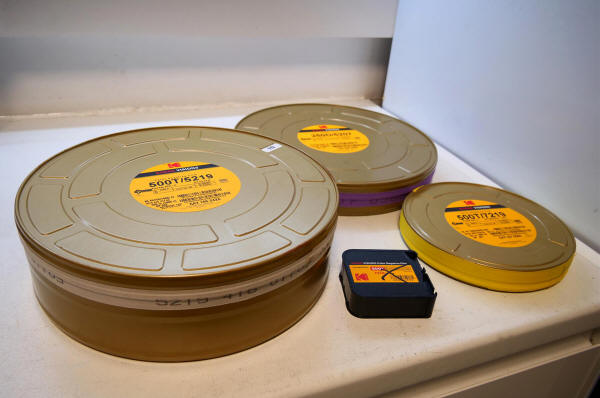 Side
by Side 65mm 35mm 16mm Super 8mm Side
by Side 65mm 35mm 16mm Super 8mmMark Trompeteler (MT): Antonio it is very kind of you to spare the time to show me around the laboratory here at Pinewood. Thanks for taking the time out to talk to me, and the many site visitors, about Kodak’s manufacture and supply of 65mm film. I was wondering, I suppose Kodak is the only current manufacturer of 65mm camera stock ? Is that the case? Antonio Rasura (AR): Yes, we are incredibly proud that wide-format 65mm is an exclusive film gauge produced by Kodak. MT: ………… and 70mm projection print stock ? AR: Same. In fact I can confirm that Kodak is the only manufacturer of colour projection print film in any format…16mm, 35mm and 70mm MT: Did you ever stop manufacturing 65mm film over the past decade or two? If so what prompted the pause in manufacturing and what has prompted the re-manufacturing and supply of 65mm film by Kodak again ? AR: No, and subsequently, since 2015, 65mm has seen a significant resurgence. The annual volume and number of titles shooting wide-format has increased year-on-year by nearly 40% over this period. |
|
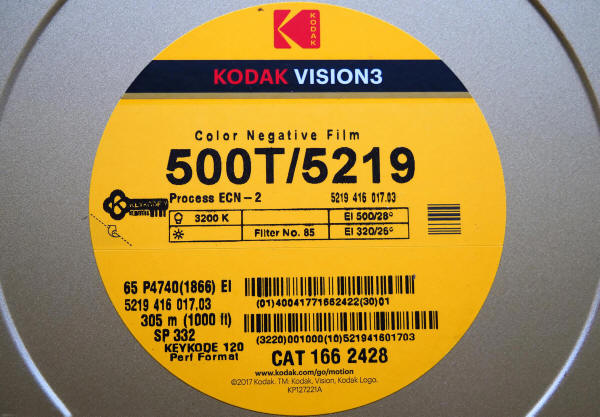 1000
foot can of 65mm film Label 1000
foot can of 65mm film LabelMT: Antonio…… for the benefit of the many site visitors – can you very briefly sum up the process by which Kodak manufactures a can of 65mm camera stock? AR: We slit and cut all camera negative in various lengths from 50 ft to 1000 ft and in all formats, 8, 16, 35 and 65mm film from wide rolls that initially start off measuring 45 inches wide and 6000 ft long. The wonderful thing about that is the very film that goes into a vintage super 8 camera, is the same, but for the width, that goes into an IMAX camera. Film enthusiasts looking to obtain their first experience with film can enjoy the same ‘film technology’ that goes into the negative that is used for wide-format 65mm origination. 70mm print is slit from wide rolls measuring an impressive 54 inches wide and 12,000 ft long. Again we slit 16, 35 and 70mm from these same wide rolls. MT: Could you very kindly outline what film stocks you are currently manufacturing and supplying in 65mm film? Briefly what are the specific recommended uses for each of them? AR: Kodak offers 65mm in our four colour negative speeds. We have two daylight-balanced stocks, 50 and 250 (low and medium speed) and two tungsten-balanced film stocks, 200 and 500 (medium and high speed). This range covers the needs of the cinematographer for interior, exterior, and mixed lighting environments. |
|
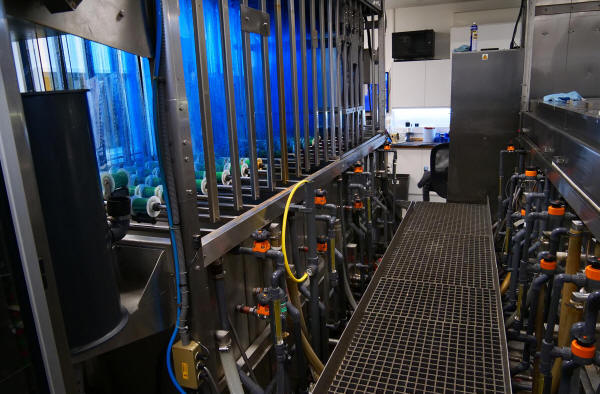 35mm
65mm Silver Sprinter Processor at Kodak 35mm
65mm Silver Sprinter Processor at KodakMT: My understanding is that there are only three laboratories in the world capable of processing 65mm film, you here at Pinewood, Cinelab just down the road in Slough, and FotoKem in Los Angeles. Only one lab left in the world capable of producing 70mm release prints – that being FotoKem. AR: FotoKem has specialised in wide format 65/70 for decades. The introduction of 65mm negative processing lines in the UK was in response to several productions shooting in the UK. The risk associated to shipping unprocessed film back to the west coast had become a significant dissuading factor, which we felt needed addressing if we were to support wide-format. MT: How does the technical quality, contrast, resolution and grain structure of what you are manufacturing in 65mm today compare to the stock that you were last manufacturing, the stock that was being used in making the classic road show movies, musicals and epics of the 60’s and 70’s say? AR: There has been significant advancements in emulsion science over this period. Much of this can be found in our Chronology of Film section on the Kodak website. One of the more notable innovative developments was the introduction of T-Grain technology, around the late 80’s early 90’s. This altered the structure of the silver halide grains from cubic to tabular. This breakthrough facilitated the production of faster emulsions, with higher efficiency in the way silver responds to and processes light. Development in faster, finer-grained films, with ever increasing latitude performance continued - and in the late 90’s we introduced the first of an entirely new platform called VISION. Progression on this platform was rapid, seeing a total of three generations in as little as 15 years. VISION 3 was yet another significant breakthrough with the introduction of technology called dye layering, which, among other benefits, significantly improves our films response to light and extended the dynamic range by an impressive 2 stops. |
|
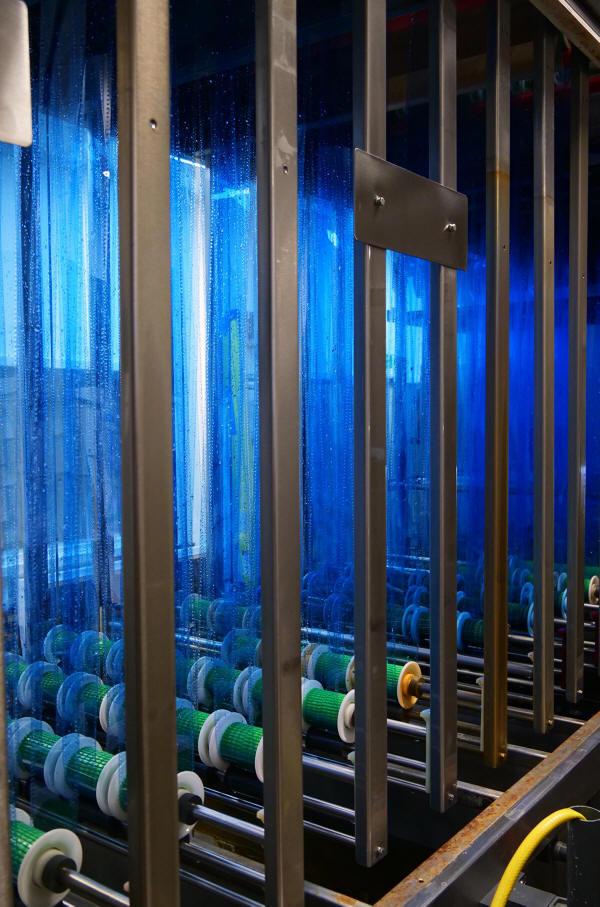 35mm
/ 65mm Kodak Processor 35mm
/ 65mm Kodak ProcessorMT: What is the current demand for 65mm? Is it a question of manufacturing on demand? Or is there a certain stock level being maintained? AR: Most of our camera film, and many of the other distribution and preservation film stocks, are available on call. That is, we hold inventory of product in the US and in Europe, making access to film readily and immediately available. We hold at least one speed of 65mm for smaller productions in low quantity, but typically produce larger quantities, in a variety of custom finish lengths, on demand for the larger shows. MT: Given industry sensitivities about intellectual property are you able to give us any idea as to who specifically, or perhaps more generally, has been, and is buying and using 65mm film? AR: There is always a huge amount of studio and social publicity on work that originate in IMAX, or any film in general. Kodak publishes a full list on our webpage. The most recent and highly anticipated film originated in IMAX is Christopher Nolan’s "Oppenheimer". MT: There is obviously a lot of excitement amongst 65/70 mm and large wide format fans about “Oppenheimer“. I understand that there have been 30 x 15/70mm IMAX prints struck, 113 x 70mm prints and at least 80 x 35mm prints struck. On top of the additional order for all the 65mm camera stock this must be a good advertisement for Kodak film? In addition “Oppenheimer“ uses 65mm black and white film prominently. I understand that Adele used 65mm for "Hello" but this was all colour stock. AR: Kodak has not, in contemporary times (40 years), produced B&W in 65mm. “Oppenheimer“ was partly shot on Kodak 5222 – B&W 65mm, which was specially manufactured by Kodak for this film. The film was processed at FotoKem who specifically set-up a unique process for Christopher Nolan. Purists will tell you that there is a ‘look characteristic’ unique to B&W film, that cannot be completely matched by desaturating colour film stocks. We are delighted to see this was made possible with the involvement of Kodak, FotoKem, IMAX and Panavision as B&W requires different handling techniques through the entire workflow. |
|
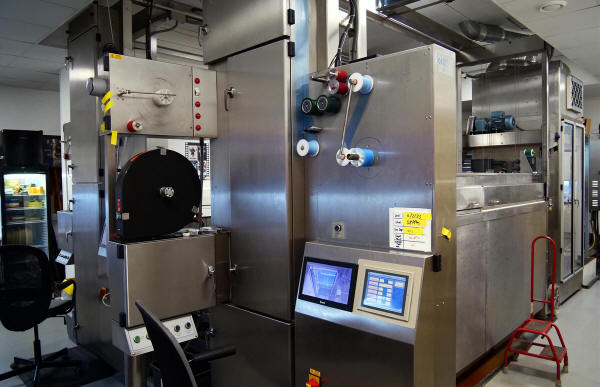 35mm
65mm Silver Sprinter Processor at Kodak 35mm
65mm Silver Sprinter Processor at KodakMT: There is of course the Adele instance - do you know if 65mm is being used solely for whole features or for other more specialist non feature uses too? AR: Yes, 65mm has been used several times on commercials and music videos. An example here in the UK in 2020 was on a music film by Paul McCartney and Emma Stone – "Who Cares" – where they mixed formats and shot on both 16mm and 65mm film which featured in70mm.com. There are also a couple of other applications working with film in a non-traditional motion picture setting. And, more recently, we are working on a very special project shooting on 65mm in a novel manner. This is unfortunately still under non-disclosure, but check back again soon for more details. MT: As a technical expert in 65mm film where do you think we are in comparing 65mm film to 4K & 8K Digital? AR: 65mm is currently being scanned at up to 14K – this is as far as the scanner & sensor technology goes right now – However, IMAX already note that 15-perf is capable of delivering up to 18K. MT: I guess that it is mainly 65 mm acquisition and then everything is digital in post production and exhibition after scanning into the digital domain? AR: That is certainly correct from a VFX perspective, but film lies at both ends of that workflow. Capture on 65mm, then the film is scanned for Digital Post Production and finally there is a choice for both digital as well as traditional 70mm print film distribution. MT: Are you aware if anybody has in more recent times been going through 65mm workflow, through to celluloid film editing, and then through to grading on film and then finally through to a few final 70mm release prints as well as lots of DCPs ? AR: Yes, a ‘traditional negative cut’ is still performed on request. This is a specialist craft with very few people in the world who are masters in this field. Simone Appleby, is Europe’s only working 65mm neg cutter and is often requested to cut high profile films in 5 perf 65mm. In the US its James Manke, another experienced 65mm neg cutter. However, it should be noted that even in an all-digital post workflow, the introduction of visuals and colour correction is always very carefully managed, so as to avoid losing the organic properties that film contributes to the overall look of the picture. |
|
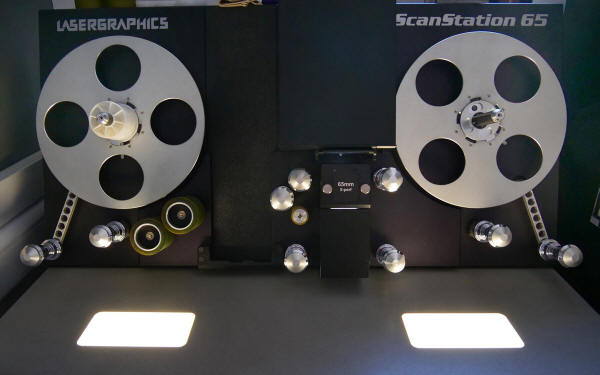 Lasergraphics
ScanStation65 Lasergraphics
ScanStation65MT: Do you know if anyone is going Digital to 65mm film, then back to Digital, to achieve a 65mm look? AR: Yes, the attraction in emulating some of the textural qualities of film in an all-digital workflow, has seen an increase in demand. FotoKem offer a service called SHIFTai and elsewhere this is referred to as digital-film-digital DFD. Merging the two technologies provides filmmakers with the ability to harness the look of film in a situation where limitations prevent them from originating on film. MT: Does the UK offer 65mm scanning services? To what kinds of Digital outputs? AR: Yes. Kodak and its partners, Digital Orchard, offer dailies scanning for 65mm with a resolution output of 6.5k. There is also a high-resolution scanner (OXSCAN), capable of 12k scans – based at Cinelab London. This makes the UK fully equipped at servicing 65mm from capture to post. |
|
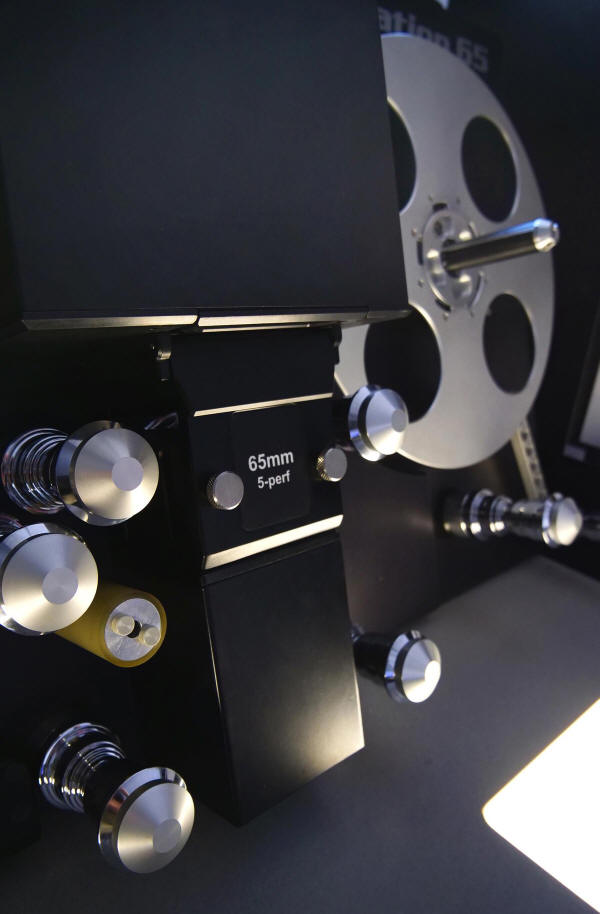 Close
up of Lasergraphics Scanstation Close
up of Lasergraphics ScanstationMT: Is 65mm / 70 film being used for visual effects, back projections, specialist uses like theme park rides? AR: VP (Virtual Production) and XR (Extended Reality) has exploded into this space. A recent collaboration between Kodak, Arri and Panavision, developed and produced by Pathway XR Studio, saw the production of an outstanding demo converging both analogue and digital technologies - originating on 65mm – take a look here MT: I know that earlier you spoke of projects involving Kodak that still are under non-disclosure. Information is “out there” circulating about Kodak and IMAX jointly developing a new IMAX camera that will be silent, able to be loaded with bigger reels of 65mm film, and silent enough to enable dialogue to be recorded during a take. If you also consider the development of the Logmar Magellan 65 camera and the news of the potential development of a Tribe 7 Blackwing 8 perf 35mm VitsaVision camera with parallel video capture - do you think we might be at a tipping point for a significant resurgence of large analogue film formats being more widely integrated into our digital cinema age? AR: Early 2022 there was indeed an exciting announcement of a multi-organisation collaboration between IMAX, Panavision, Kodak and FotoKem in support of the production of 4 new IMAX cameras. Kodak has also worked closely in support of Logmar with their Magellan camera, which we eagerly anticipate will become available in the very near future. We are delighted to see large scale investment and innovation come to market in support of wide-format. These developments compliment and underscore Kodak’s commitment to support 65mm FILM. MT: Antonio thanks so much for sharing this with us. Is there anything else you would like to add? AR: Thank you for visiting with us Mark. We are thrilled with all the interest in FILM across all formats, which is very much living in a period of renascence. Filmmakers are ever more frequently turning toward the beauty that film offers, and in particular with the unrivalled cinematic grander 65mm. – appreciate your time. As a little afterthought to mention to the reader. I recently purchased an analogue still camera manufactured in 1972 for £150, as an addition to my 2021 £1000 digital still camera. The 1972 camera, requiring no batteries, is in perfect working order, it uses the 6cm x 6cm negative format, much bigger than 35mm. In my own little way I have been shooting on Kodak film again recently, …. and I love it ! |
|
| Go: back - top -
back issues -
news index Updated 22-01-25 |
